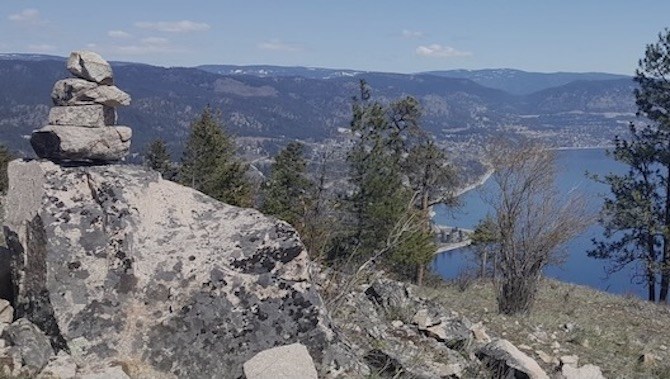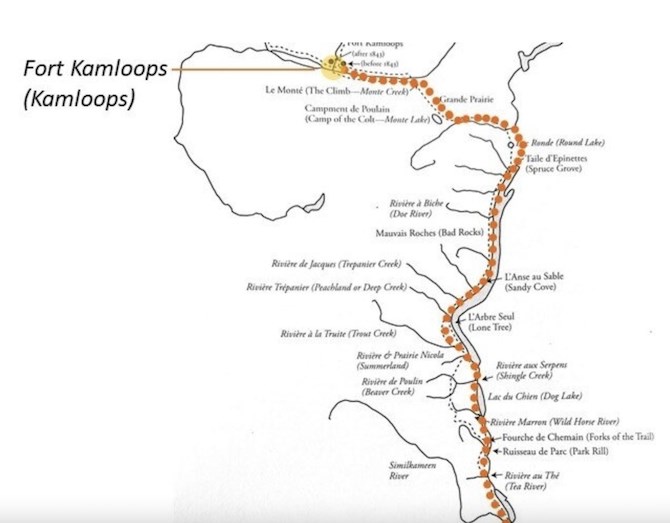
This section of the Trail of the Okanagans between Summerland and Peachland is also one of the few remaining pieces of the original Okanagan Fur Brigade Trail.
Image Credit: SUBMITTED / Trail of the Okanagans
April 19, 2021 - 7:30 AM
The Trail of the Okanagans Society describe themselves as advocates for the development of a continuous, non-motorized, multi-use pathway connecting all communities between Osoyoos and Sicamous, but the society also has a larger goal – to make a trail connection south of the Canada-U.S. border to Brewster, Washington.
Trails of the Okanagan President Janice Liebe says she learned a lot about the trail’s past when examining excerpts from Okanagan writer Ken Mather, who recently published Trail North - The Okanagan Trail of 1858-68 and its origins in British Columbia and Washington.
The trails society sees a connection to Brewster as the historical end to the trail which first began use by the Europeans as the fur brigade trail early in the 1800s.
“Today’s trail more or less follows the old brigade trail. It has adapted to what was going on over the years as a major transportation route,” Mather says.
He says geography is important to understand in the story because of the dependence travellers had on the west’s river systems. The Okanagan was connected to the larger Columbia River system, which is how many early goods were shipped into, and out of, the interior of British Columbia in the 1800s.
Mather says prior to the Northwest Company adopting the route through the Okanagan in 1811, the trail had been in use by First Nations for thousands of years. The fur traders used old Fort Okanogan near modern day Brewster as their jumping off point for travel further north through the Okanagan valley.
Mather says the site of the old fort is now under water due to flooding of the Columbia River.
“The route through the Okanagan was part of a larger overland route alongside the Fraser, beginning near Prince George and running through Kamloops and the Okanagan, to Fort Okanagan. Furs were hauled south and European trade goods flowed north, generally coming in through the Columbia to the Okanagan River,” Mather says.
The 1846 treaty that established the 49th parallel as the U.S.-Canada border put an end to the use of the Okanagan valley as a fur-trade conduit, which was re-routed through Fort Langley on the Lower Mainland.
The Okanagan trail fell into disuse for about a decade before finding new prominence as a way to the goldfields of the Cariboo in central B.C. in the early 1860s.
“Parties of miners began using the trail, then merchants and ranchers, bringing cattle to the gold fields. By the late 1860s, 22,000 cattle had been driven up the Okanagan valley in what had become a major transportation route to the interior,” Mather says.
Today’s Trail of the Okanagans is a modern version of the historical route.
While it does not follow the exact route of the past, part of the trail between Summerland and Peachland actually uses a portion of the old brigade trail that has seen little use since the early days.
“The Okanagan trail today is basically the same concept - to make it from one end of the valley to the other, keeping in mind the Okanagan valley really belongs on both sides of the border,” Mather says.
The vision for a new trail could restore the route to former significance, this time as an international cycling destination.

The historic Okanagan Fur Brigade Trail, which went from Kamloops to Fort Okanagan, located near the modern day community of Brewster, WA.
Image Credit: SUBMITTED / Trail of the Okanagans
To contact a reporter for this story, email Steve Arstad or call 250-488-3065 or email the editor. You can also submit photos, videos or news tips to tips@infonews.ca and be entered to win a monthly prize draw.
We welcome your comments and opinions on our stories but play nice. We won't censor or delete comments unless they contain off-topic statements or links, unnecessary vulgarity, false facts, spam or obviously fake profiles. If you have any concerns about what you see in comments, email the editor in the link above.
News from © iNFOnews, 2021